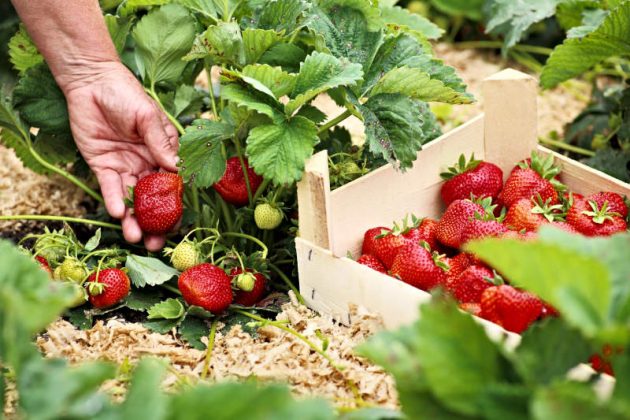Discover the joy of… Grow Your Own – Strawberries
Strawberries can be considered the ideal fruit, it’s herbaceous and easy to cultivate from the runners. You’ll only have to wait 12 months from planting for the plant to produce fruit, and it’s the first outdoor fruit to come into season.
Strawberries are versatile when it comes to growing, making optimising the space available in your outdoor space easy. For those limited by space try growing strawberries in a hanging basket, picking the fruit that hangs down, and for those who have ground space to give over to growing fruit and veg, they will happily grow in open ground or containers.
If you’re looking for a fruit to grow with little ones, then strawberries are a great place to start as children will love their reliability, some varieties fruiting for up to 9 months of the year, but all reward with mouth-watering flavours.

Where to grow
Strawberries do best in an open sunny site, sheltered from strong, cold winds and spring frosts. They won’t thrive in shady locations, in close proximity to hedges or in acid soil. Make sure that the soil is free draining and with good organic matter added, such as manure, leaf mould, or a multipurpose compost.
Watering
Water frequently while new plants are establishing and make sure to water during dry periods during the growing season. Try to avoid wetting crowns and the fruit as this can promote disease.
Planting
Plant out in July – October to fruit the following year. You can plan out in Feb – April if the weather is mild. Ensure that the base of the crown rests lightly on the surface; if the crown is planted too deep it will rot, if the crown is planted too shallow the plant ill dry out and die. We suggest planting three or more of any one variety to ensure a large enough harvest, alternatively think about choosing a range of varieties that will stagger fruiting periods to ensure continuity through the seasons as much as possible. Strawberries can suffer from soil-borne pests and diseases so try to avoid planting strawberries in the same location as previous strawberry plants. Minimise rotting when lying on the soil, soil splashes and generally keeping the fruit clean by putting down a layer of fresh straw or strawberry mats. The straw or matting will have the added benefit of supressing weeds, but pull any that do emerge. After the plants have finished cropping remove any old and discoloured leaves, this will allow fresh leaves to develop. You’ll also need to remove any straw or strawberry matting to prevent a build-up of pests and diseases.
Feeding
Plants grown in open ground will benefit with manure or leaf mould and composted bark, or those that are grown in hanging baskets or containers will want a liquid feed like Tomorite (high in potash) or Miracle Gro during the growing season.
Propagating
Strawberries can be propagated by seed or by dividing larger plants, but the best and easiest way is by runners. You will notice runners forming from July, once they’re large enough they can be removed from the parent plant and planted or potted up. Try pegging the plantlets away from the parent plant directly into the ground or into pots with bent wire, wooden pegs or even hair pins. You can then cut the connecting runner once the plantlet has become established. Strawberry plants will crop well for about 4 years before the need to replace them, but with propagation so easy you shouldn’t find yourself without plenty of plants to continue with.
Pests
As much as we love to see birds in the garden, we don’t want them helping themselves to our fruit crops. Particularly look out for blackbirds, thrushes and starlings – they like strawberries almost as much as children do! To protect your strawberry plants cover them with garden netting.
Slugs, snails, aphids and caterpillars are common pests with strawberries. They can be controlled if desired with the appropriate chemicals or copper tape. Speak to a member of our Garden Care team for more information.
Powdery Mildew, Leafspot and Botrytis are the main diseases that affect strawberries. The infected fruit or the plant should be destroyed when signs of the diseases are first seen.
Powdery Mildew appears as a white powder deposit over the surface and leaves become stunted and shrivel.
Leafspot appears as circular, dark purple spots on the leaf surface. Botrytis, also known as Gray Mold appears as a spreading brown rot and fuzzy mold on ripening berries.
Varieties
Honeoye – Early season. Heavy cropper and extremely disease resistant.
Cambridge Favourite – Mid season. Excellent flavour and texture.
Hapil – Mid season. Good all round variety.
Elsanta – Mid season. Good pot or basket type.
Sweetheart – Mid season. A compact plant that produces large fruit with a good flavour.
Elegance – Mid season. Good container plant with good disease resistance.
Symphony – Mid – late season. Good flavour.
Florence – Late season. Good pest and disease resistance.
Pegasus – Late season. Excellent for organic growing.
Flamenco – Everbearer / All season. Long cropping season from May – Nov.




